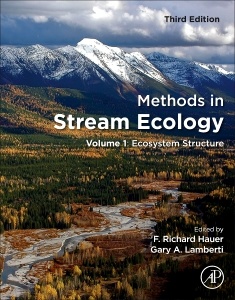Description
Methods in Stream Ecology (3rd Ed.)
Volume 1: Ecosystem Structure
Coordinators: Hauer F. Richard, Lamberti Gary
Language: English
Subject for Methods in Stream Ecology:
506 p. · 21.4x27.6 cm · Paperback
Description
/li>Contents
/li>Readership
/li>Biography
/li>Comment
/li>
Methods in Stream Ecology provides a complete series of field and laboratory protocols in stream ecology that are ideal for teaching or conducting research. This two part new edition is updated to reflect recent advances in the technology associated with ecological assessment of streams, including remote sensing. Volume focusses on ecosystem structure with in-depth sections on Physical Processes, Material Storage and Transport and Stream Biota. With a student-friendly price, this Third Edition is key for all students and researchers in stream and freshwater ecology, freshwater biology, marine ecology, and river ecology. This text is also supportive as a supplementary text for courses in watershed ecology/science, hydrology, fluvial geomorphology, and landscape ecology.
Methods in Stream Ecology, 3rd Edition, Volume 2: Ecosystem Structure, is also available now!
Section A. Physical Processes 1. Riverscapes 2. Valley Segments, Stream Reaches, and Channel Units 3. Discharge Measurements and Streamflow Analysis 4. Dynamics of Flowing Water 5. Fluvial Geomorphic Processes 6. Temperature 7. Light 8. Hyporheic Zones
Section B. Stream Biota 9. Heterotrophic Bacteria Production and Microbial Community Assessment 10. Fungi: Biomass, Production, and Community Structure 11. Benthic Stream Algae: Distribution and Structure 12. Biomass and Pigments of Benthic Algae 13. Macrophytes and Bryophytes 14. Meiofauna 15. Macroinvertebrates 16. Fish Assemblages 17. Amphibians and Reptiles
Section C. Community Interactions 18. Invertebrate Consumer–Resource Interactions 19. Macroconsumer–Resource Interactions 20. Trophic Relationships of Macroinvertebrates 21. Macroinvertebrate Drift, Adult Insect Emergence and Oviposition 22. Trophic Relations of Stream Fishes
- Provides a variety of exercises in each chapter
- Includes detailed instructions, illustrations, formulae, and data sheets for in-field research for students
- Presents taxonomic keys to common stream invertebrates and algae
- Includes website with tables and a link from Chapter 22: FISH COMMUNITY COMPOSITION to an interactive program for assessing and modeling fish numbers
- Written by leading experts in stream ecology




